

The future of intelligent assistants in online training. Online Business Awards Every time a brand new and revolutionary tech knocks at an industry’s doors, everyone is a bit skeptical about it.

Intelligent assistants were no exception. In fact, they didn’t start as well as everyone hoped. They appeared clunky and inconsistent, unable to understand human interaction and provide the best answers. Having said that, over the past couple of years, things have changed for the better. This tech has many diverse applications, but we are going to focus on the use of intelligent assistants in online training. How will these smart assistants affect LMS software? How will the future of online training with intelligent assistants look like in general?
Instant meaningful feedback Instant feedback during the learning process and the very assessment bear many benefits for learners. To achieve the best results, the feedback has to be meaningful. The benefits of this practice are many, both for the organization and the learners: Automation of instructors’ tasks.
Traitement naturel du langage : tout savoir sur le Natural Language Processing. Le traitement naturel du langage, aussi appelé Natural Language Processing ou NLP en anglais, est une technologie permettant aux machines de comprendre le langage humain grâce à l’intelligence artificielle.

Découvrez tout ce que vous devez savoir à ce sujet. EZZRATY LES USAGES DE L'IA. Conversational AI ‒ but where is the I? - Wluper Blog - Medium. I remember the first time I saw a computer, it was a Power Macintosh 5260 (with Monkey Island on it).

I was around 5 years old and I looked at it as if it belonged to another universe. It did, I was not allowed to get anywhere close to it within a 5 mile radius; it was my older brother’s! That did not stop me. I browsed it for hours. The possibilities of computers were infinite and fuelled by the inspiration of sci-fi worlds the dream of talking machines, machines that can assist humans, think themselves and even have feelings never stopped.
Fast forward 20 years. How Duolingo is using AI to humanize virtual language lessons. “The core part of our AI strategy is to get as close as possible to having a human-to-human experience,” Duolingo AI and research head Burr Settles told VentureBeat in an interview at London’s AI Summit last month.
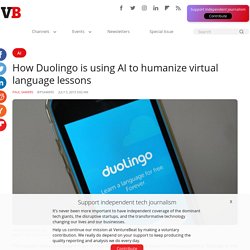
Duolingo, for the uninitiated, is a cross-platform app where users can learn languages for free, though they can also cough up $7 each month for a premium service that removes ads, delivers offline access, and more. Through gamification and bite-sized lessons, anyone can learn to read, listen, and speak in dozens of tongues. People’s reasons for learning a new language vary — perhaps it’s to boost their appeal with prospective employers, to converse with a new partner’s parents, or simply for personal fulfillment.
But whatever the motivation, learning a language takes time and effort — all the more so if the learner is not immersed in the language 24/7. Above: Duolingo. 7 Best Language Learning Chatbot Apps for 2020. Developing chatbot applications for multiple businesses, domains, and industries have become a trend now.
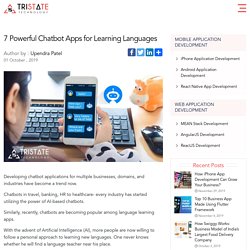
Chatbots in travel, banking, HR to healthcare- every industry has started utilizing the power of AI-based chatbots. Similarly, recently, chatbots are becoming popular among language learning apps. Demystifying the Virtual Agent vs Chatbot Debate. Artificial intelligence (AI) is playing an increasingly prominent role in technological change across industries, especially in industries that can leverage the technology to deliver customer service functions.

Although chatbots have been around for decades now, the idea of a virtual agent that can seamlessly interact with customers, provide relevant information, and even complete basic functions like booking an appointment or scheduling a call-back is relatively new. On top of that, there seems to be a general confusion surrounding the difference between artificial intelligence robots, chatbots, and virtual agents—aren't they all really the same thing?
The truth is that with the rapid development of AI technology and an increasing number of companies marketing proprietary AI products, it's getting more difficult to keep up with the appropriate terminology and evolving capabilities of web-deployed bots. In addition, most tech vendors want to market their product as "the next big thing. " AI in Education: How chatbots are transforming learning. Artificial intelligence coexisting with our daily lives is no longer an idea firmly based in the ‘crackpot theory’ realm of futuristic possibilities — AI is already pervasive in our current world.
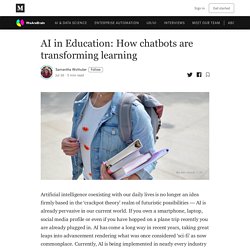
If you own a smartphone, laptop, social media profile or even if you have hopped on a plane trip recently you are already plugged in. AI has come a long way in recent years, taking great leaps into advancement rendering what was once considered ‘sci-fi’ as now commonplace. Currently, AI is being implemented in nearly every industry on the planet at such a rapid rate that many of us didn’t even notice the pivot from paper to binary. From the retail, healthcare, economic and transport industries (to name a few), AI plays a major role in creating efficiency and reliability at a fraction of the cost.
It’s revolutionising these industries for the better and the way we view them is changing by the minute. There are many ways AI is transforming the education industry. Systematic review of research on artificial intelligence applications in higher education – where are the educators? Journals, authorship patterns and methods Articles per year There was a noticeable increase in the papers published from 2007 onwards.
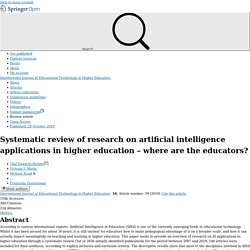
The number of included articles grew from six in 2007 to 23 in 2018 (see Fig. 2). Number of included articles per year (n = 146) Journals The papers included in the sample were published in 104 different journals. Countries. The man who helped invent virtual assistants thinks they’re doomed without a new AI approach. Siri, Alexa, Google Home—technology that parses language is increasingly finding its way into everyday life.

Boris Katz, a principal research scientist at MIT, isn’t that impressed. Over the past 40 years, Katz has made key contributions to the linguistic abilities of machines. Conversational AI: Design & Build a Contextual AI Assistant. The Case for Chatbots in Corporate Learning. Raise your hand if you love corporate training Most employees hate the learning they get asked to do at work.
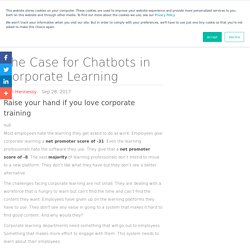
Employees give corporate learning a net promoter score of -31. Even the learning professionals hate the software they use. Why AI Assistants are the Future of Corporate Training. Guest Contribution by Harish Agrawal. New Technology Tools Can Help Retain Top Talent. In today’s tight talent market, retaining your best employees can be just as important as recruiting promising new ones. A significant amount of staff turnover, or losing a smaller number of valued employees, can keep an organization from achieving its business goals. Employers may find that investing in employee training and upskilling can be a significant value driver, helping them diversify their capabilities, engage their workforce and boost retention.
In addition to traditional methods, such as job shadowing and mentoring, new technologies are providing additional ways to manage and retain employees. 4 Learning Trends Making a Splash in the Corporate Training World. In today’s competitive market, a successful organization is one that embraces change, adapts its business processes, and equips its employees with the required job skills to drive maximum business results. However, the industry is evolving and so are the ways in which corporate training is being offered. Today’s ever-advancing technologies and learning trends give companies an opportunity to offer training in more innovative ways than ever. Don’t Treat Your Chatbot as a Tool but as a Member of Your L&D Team. Many organizations have started developing chatbots, attracted by the allure of artificial intelligence’s promise of increased productivity, capacity and user satisfaction.
As with any adoption of new technology, these initial experiences have been mixed in their results; implementation has been more cumbersome and complex than first imagined, and user experiences have been too robotic and off the mark. However, these lackluster results should not dissuade other organizations from jumping into the fray. In fact, we can now thank those brave early adopters for paving the way to understanding what works and what doesn’t. Chatbots are a compelling technology to support a corporate learning and development (L&D) program, because they address the fundamental challenge of learner engagement. Chatbots are designed around a conversational user experience, which means that engaging with a chatbot can be as frictionless as engaging with a colleague or a friend. Job Title Rules of Engagement. The Benefits of Chatbots for Your Business. Chatbots are evolving at an accelerated pace, and there’s a pretty good chance that we have all interacted with an artificially intelligent chatbot at least once.
In recent years, chatbots have started to play a more prominent role in enterprise operations across industries. Today, chatbots can be integrated into apps, social media platforms, and websites to enhance customer service functions and marketing strategies. Ten Secrets to transforming L&D with a Chatbot. Chances are when you’re seeking customer support online you’re interacting with a bot rather than a human agent. They’re increasingly reliable and they don’t have the human frailties of needing a break, falling ill, or forgetting key information.
They’re already being used in education, so why not employ one to transform your organisation’s L&D? Chatbots as instructors and mentors in the workplace can make a real impact, but first you need to make L&D ready for the bots. Here are some secrets to making chatbots in L&D a real success. It’s been estimated that up to 50% of what you learn in a training session is left there as you walk out of the classroom or switch off your computer.
Having a bot in the workflow allows employees to have the information and training they need to do their job when and where they need it, rather than having them step away from the desk into a classroom or taking them to another screen to participate in an online course. 2. Chatbot. Chatbot et Big Data : les agents dépendent des données. Chatbot et Big Data sont deux technologies de pointe inextricablement liées. Découvrez comment les agents conversationnels collectent, analysent et exploitent les mégadonnées. Vous les voyez sur de plus en plus de sites web et de réseaux sociaux. Chatbot Revolution Online: Merging Neuroscience and AI for a New Way of Learning Tickets, Mon, Jan 13, 2020 at 7:00 AM. Three Online Sessions: Monday, January 13, 20, and 27. 10 a.m. - 12:30 p.m.
EST. Tutorbot : les défis d’une utilisation innovante des chatbots dans l’éducation. Le plan de travail de notre partenariat est basé sur le principe d’essayer, de tester, d’améliorer et de réessayer. Actuellement, la plate-forme technique est développée conjointement au premier chatbot du projet, que nous appelons “chatbot alpha”. L’objectif est d’itérer les processus avec un partenaire afin de fournir un ensemble de lignes directrices aux trois autres partenaires de la formation professionnelle qui développeront les chatbots “beta”. About – Mr Winston. But, even if many VET providers offer English language courses, that critical skill on the job market is not mastered by all learners. How Duolingo is using AI to humanize virtual language lessons.
7 of the Best Language-Learning Chatbot Apps. Language learning tools and translators have been in high demand for years. To be bilingual or multilingual opens up so many opportunities for both your career and for interacting with others from different cultures. Learning with WhatsApp, chatbots and other IM services. Social messaging apps are now more popular than any other service. The three most popular messaging services – WhatsApp, Facebook Messenger and weChat – are used by several billion people, nearly half of the entire human race.
More or Less Human. Jad Abumrad: The Vision - Digital interaction in the classroom. Edtech AI V2. The use of artificial intelligence (AI) in education. The rise of technology within the education sector over the last few decades has been astounding. This is certainly the case if we consider that teaching with technology has become pervasive in almost every classroom environment. Quelle place pour les robots dans le tutorat à distance ? 3 Real-Life Examples of Artificial Intelligence in Education. (3) A teaching assistant named Jill Watson. Jill Watson, Round Three. IBM Watson : tout savoir sur le superordinateur IA et Big Data.